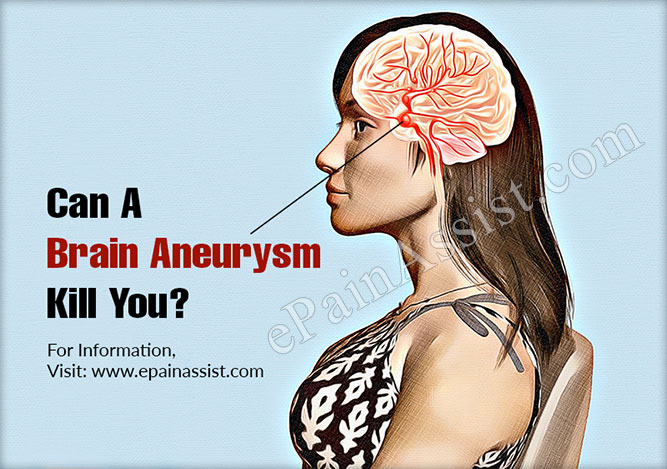Aneurysm implies a balloon type of bulge structure present in an artery wall. With the consistent growth of aneurysm, pressure creates on nearby structures and causes rupture eventually. Ruptured form of aneurysm thus releases blood in spaces nearby the brain to form a life-threatening stroke i.e. subarachnoid hemorrhage. Treatment of this problem thus dedicates on stopping the blood flow and repair of aneurysm by the help of different techniques, which include bypass, coiling and clipping methods. Aneurysm mostly takes place on large blood vessels i.e. at different branches of arteries. About 80percent of aneurysms formation takes place in the anterior circulation or in front part of the human brain, while 20% takes place in its back or posterior circulation.

Causes of Brain Aneurysm
SAH (subarachnoid hemorrhage) and brain aneurysm problem may take place in individuals because of alcohol intake, high blood pressure, smoking, genetic problems, oral contraceptives, atherosclerosis and individuals’ lifestyle. Neurologists have identified separate risk factors for both formation of and ruptured forms of brain aneurysm problem. These include-
Formation of Brain Aneurysm Risks
Researchers have identified the following activities contribute towards risk factors related to the formation of brain aneurysm in patients-
- High blood pressure or hypertension
- Smoking
- Congenital resulting in walls of the artery from inborn abnormality
- Individuals with more than 40 years age
- Family history associated with brain aneurysms
- Presence of AVM i.e. arteriovenous malformation
- Cocaine and other similar types of drugs usage
- Tumors and infections
- Traumatic head injury
- Ruptured Aneurysm Risks
Doctors perceive the following major risk factors, as contributing towards brain ruptured in case of aneurysm problem.
- Hypertension
- Cigarette or tobacco smoking.
Can A Brain Aneurysm Kill You?
Facts on Death and Disability of Brain Aneurysm:
Approximately 6 millions of people staying in different regions of United States suffer from un-ruptured type of brain aneurysm i.e. 1 among 50 people.
Annual rate associated with ruptured form of aneurysm is about 8 to 10 among 100,000 people or approximately 30,000 people in different areas of entire United States.
Ruptured brain aneurysm cases are often fatal i.e. in approximately 40 percent of total cases. Moreover, remain 60%, who survived mostly deal with disabilities or permanent type of neurological deficits.
About 15 percent of the total patients suffering from SAH (subarachnoid hemorrhage) die even before they reach to the hospital. A majority of deaths caused from subarachnoid hemorrhage are because of massive and rapid brain injuries because of initial bleeding, which is incurable by any surgical and/or medical intervention.
Most of the brain aneurysms are of small in size i.e. approximately in between 1/8inches and 1 inch with an approximate 50% to 80% of un-ruptured aneurysms during the entire course of an individual’s lifetime. However, aneurysm bigger than one inch implies giant aneurysm and poses relatively high risk as well as involves difficulty in the treatment.
Subarachnoid hemorrhage is the most terrible cause associated with acute headache, in which doctors perform emergency treatment of the patients. Headache accounts for about 1percent to 2 percent visit to emergency room and maximum 4percent of visits to the departments of primary care. Among total number of patients suffering from severe headache of the life and admitting to emergency room about 1percent of them deal with SAH.
Accurate early diagnosis of SAH is critical, as initial stage of it is fatal and results in devastating neurological results or results in various minor symptoms.
Despite widespread availability of neuro-imaging technique, diagnosis delays or misdiagnosis takes place in more than 25percent of total patients dealing with SAH when initially presenting for the healthcare treatment.
Approximately 500,000 people across the world die every year because of brain aneurysms (both formation and rupture), while half of such victims are of less than 50 years age.
- Title: “Brain Aneurysms.” Authors: Thompson BG, Brown RD Jr, Amin-Hanjani S, et al. Journal: Circulation. 2015 Jun 9;131(23):e626-9. DOI: 10.1161/CIR.0000000000000258 Link: https://pubmed.ncbi.nlm.nih.gov/26056350/
- Title: “Intracranial Aneurysms: Review of Current Science and Management.” Authors: Connolly ES Jr, Rabinstein AA, Carhuapoma JR, et al. Journal: Circulation. 2012 Jul 10;126(2):241-252. DOI: 10.1161/CIRCULATIONAHA.111.064315 Link: https://pubmed.ncbi.nlm.nih.gov/22777152/
- Title: “Subarachnoid Hemorrhage: Updates on Diagnosis and Management.” Authors: Etminan N, Chang HS, Hackenberg K, et al. Journal: Neurol Clin. 2016 Nov;34(4):901-917. DOI: 10.1016/j.ncl.2016.06.012 Link: https://pubmed.ncbi.nlm.nih.gov/27741985/
- Title: “Unruptured Intracranial Aneurysms: Natural History, Clinical Outcome, and Risks of Surgical and Endovascular Treatment.” Authors: Wiebers DO, Whisnant JP, Huston J 3rd, et al. Journal: The Lancet. 2003 Mar 15;362(9378):103-110. DOI: 10.1016/S0140-6736(03)13860-3 Link: https://pubmed.ncbi.nlm.nih.gov/12867109/
- Title: “Management of Intracranial Aneurysms.” Authors: Bederson JB, Awad IA, Wiebers DO, et al. Journal: Circulation. 2009 Apr 14;119(14):1871-1885. DOI: 10.1161/CIRCULATIONAHA.108.191395 Link: https://pubmed.ncbi.nlm.nih.gov/19349318/
Also Read:
- What Can Cause Brain Aneurysm or Cerebral Aneurysm and How is it Treated?
- Detecting Brain Aneurysm: What Does It Feel Like When You Have A Brain Aneurysm?
- Can You Fix A Brain Aneurysm?
- What Are The Long Term Effects Of A Brain Aneurysm?
- Is It Painful To Die From A Brain Aneurysm?
- Can You Tell if You Have a Brain Aneurysm?
- Is Brain Aneurysm Surgery Dangerous?
